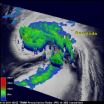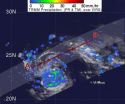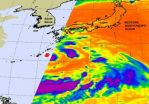(Press-News.org) DURHAM, N.H. – Beginning Sunday, September 18, 2011 at NASA's launch facility in Fort Sumner, New Mexico, space scientists from the University of New Hampshire will attempt to send a balloon up to 130,000 feet with a one-ton instrument payload to measure gamma rays from the Crab Pulsar, the remains of a supernova explosion that lies 6,500 light years from Earth. The launch is highly dependent on weather and wind conditions, and the launch window closes at the end of next week.
The Gamma Ray Polarimeter Experiment (GRAPE), which was designed and built at the Space Science Center within the UNH Institute for the Study of Earth, Oceans, and Space (EOS), is an effort to apply a new type of detector technology to the study of celestial gamma rays.
Specifically, the goal of the GRAPE project is to study the polarization of gamma rays from celestial sources. "Polarized" radiation vibrates in a preferred direction, and the extent of that polarization can provide clues to how the radiation was generated, in essence serving as a probe of the source.
Gamma rays, such as those emitted from the Crab Pulsar, are generally produced from the interactions of a highly accelerated beam of subatomic particles – massive ejections of high-energy particles that are thought to take the form of a narrow jet moving outward at nearly the speed of light.
"We think that an accelerated beam of particles is the source of the high-energy radiation from the Crab Pulsar, but the structure of that beam and the mechanism by which the radiation is generated is not entirely clear," says mission lead scientist Mark McConnell, a professor in the SSC and chair of the UNH department of physics.
Detecting gamma-ray polarization can provide astrophysicists with a better understanding of particle acceleration, a ubiquitous and important but poorly understood process that generates radiation and occurs throughout the universe – from Earth's magnetic field (magnetosphere) to pulsars and black holes.
The New Mexico-based flight, which could last as long as 40 hours, is not designed to reach the ultimate goal of the project – to study gamma-ray bursts. Achieving that will require a follow-up flight over Antarctica where the balloon, due to circumpolar winds that occur between December-January, would circle the pole for 30 to 40 days.
Says McConnell, "To study the gamma-ray burst phenomena we need much more time because they occur randomly in the sky at a rate of about once per day and last at most a couple of minutes. So a long flight will be required to measure a number of bursts."
However, McConnell notes, a successful, short-duration demonstration flight should provide the best measurements of the polarization of gamma rays emanating from the Crab Pulsar to date because of the sophistication of the instrumentation – the "polarimeter" detectors developed at UNH – capable of making the difficult measurement.
"We should be doing some very useful science on the Crab Pulsar during this flight and we only need 24 hours to do that," he says.
The concept of GRAPE has been developed at the SSC over the last 15 years and in 2007 the first small-scale demonstration balloon flight took place using a single polarimeter to prove the concept. In its current incarnation, GRAPE uses 16 polarimeters designed and built at the SSC. For a full-scale flight over Antarctica, 32 of the detectors will be used to monitor the sky for radiation from gamma-ray bursts and solar flares.
The upcoming GRAPE flight will also serve as an engineering test for two other UNH experiments that will piggyback a ride on the balloon. The Fast Compton Telescope, or FACTEL, will be flown to see how well it handles the radiation environment at high altitudes in order to assess its design.
FACTEL (an effort led by UNH physics professor Jim Ryan) is based on work SSC scientists and engineers did in helping build the Imaging Compton Telescope (COMPTEL) onboard the 17-ton Compton Gamma Ray Observatory (CGRO) that was put orbit in 1991. FACTEL represents an effort to demonstrate the latest technologies required to produce an upgraded version of COMPTEL, which should be vastly more efficient and produce much sharper imagery.
A second engineering test being performed on this flight, led by research assistant professor Peter Bloser, involves a new type of detector technology known as silicon photomultipliers. These devices are used to read out signals generated by radiation detectors. This represents a new technology that may prove valuable for many NASA space applications.
High-altitude balloons, with a volume of up to 30 million cubic feet (large enough to contain a football field) have been used to carry NASA experiments to the edge of space for more than 50 years. They provide a vastly cheaper and less time-consuming approach than satellite-based missions and afford an excellent opportunity for student research projects. Three physics graduate students are working on the current flight as part of their Ph.D. studies and several undergraduate students have also been involved in the flight preparations.
###
Photographs to download:
http://www.eos.unh.edu/newsimage/GrapeLift_lg.jpg.
Caption: The GRAPE balloon payload shown during a power-up compatibility test on September 13 at the Columbia Scientific Balloon Facility in Ft. Sumner, NM. The larger vessel contains the GRAPE instrument. The smaller vessel on the right houses the FACTEL test instrument. Photo by Mark McConnell, UNH-EOS.
http://www.eos.unh.edu/newsimage/CrabNebula_lg.jpg.
Caption: The Crab Nebula. Photo courtesy of NASA.
The launch can be viewed via a NASA live feed at http://www.ustream.tv/channel/csbf-operations
Balloon-based experiment to measure gamma rays 6,500 light years distant
2011-09-19
ELSE PRESS RELEASES FROM THIS DATE:
Breeding soybeans for improved feed
2011-09-19
MADISON, WI, SEPTMEBER 12, 2011 -- Modifying soybean seed to increase phosphorus content can improve animal nutrition and reduce feed costs and nutrient pollution. However, further research is needed to commercialize this valuable technology. Knowledge of soybean and other crops such as maize suggest that reducing phytate, the principle storage form of phosphorus in plant tissue, in seeds reduces seed germination and emergence of seedlings in the field. In soybean, however, researchers debate whether this problem exists, and suggest that other factors may be the cause.
New ...
Lasers could be used to detect roadside bombs
2011-09-19
EAST LANSING, Mich. — A research team at Michigan State University has developed a laser that could detect roadside bombs – the deadliest enemy weapon encountered in Iraq and Afghanistan.
The laser, which has comparable output to a simple presentation pointer, potentially has the sensitivity and selectivity to canvas large areas and detect improvised explosive devices – weapons that account for around 60 percent of coalition soldiers' deaths. Marcos Dantus, chemistry professor and founder of BioPhotonic Solutions, led the team and has published the results in the current ...
NASA sees power within hurricane Maria as it heads for a landfall in Newfoundland
2011-09-19
VIDEO:
This animation of NOAA's GOES-13 satellite observations from Sept. 6 at 8:45 a.m. EDT through Sept. 16 at 7:45 a.m. EDT shows the movement of Hurricane Katia followed by Tropical...
Click here for more information.
Hurricane Maria joins twelve other hurricanes on record to make landfall in Newfoundland, Canada, and NASA satellite imagery revealed its inner strength.
The Tropical Rainfall Measuring Mission (TRMM) satellite passed over Hurricane Maria on Sept. ...
NASA's TRMM satellite sees moderate rainfall Tropical Storm Sonca
2011-09-19
When the Tropical Rainfall Measuring Mission (TRMM) satellite flew over Tropical Storm Sonca on Friday, Sept. 16 it found moderate rainfall mostly on the southern side of the storm. Chichi Jima can expect some of that rainfall over the weekend as Sonca passes east of the island.
TRMM passed over Tropical Storm Sonca and its precipitation radar instrument saw moderate rainfall occurring mostly on the southern side of the storm, while light-to-moderate rainfall was occurring throughout the storm. The southern edge of the storm had rainfall rates between .78 to 1.57 inches ...
Infrared satellite data shows Tropical Storm Roke strengthening
2011-09-19
Tropical Storm Roke has changed in size and is starting to change in strength. Roke appears to be consolidating in infrared imagery from NASA's Aqua satellite.
Roke began its life as a monsoon depression with a large low-level circulation center that over time consolidated and organized. The eastern half of Tropical Storm Roke was seen in an infrared image from NASA's Aqua satellite AIRS (Atmospheric Infrared Sounder) on Sept. 15, and it showed a more consolidated center with strong convection and very cold cloud-top temperatures.
Cloud-top temperatures are important ...
Study suggests possible link between two Type 2 diabetes drugs and pancreatic cancer
2011-09-19
Two newer drugs used to treat Type 2 diabetes could be linked to a significantly increased risk of developing pancreatitis and pancreatic cancer, and one could also be linked to an increased risk of thyroid cancer, according to a new UCLA study.
Researchers from the Larry L. Hillblom Islet Research Center at UCLA examined the U.S. Food and Drug Administration's database for adverse events reported between 2004 and 2009 among patients using the drugs sitagliptin and exenatide. They found a six-fold increase in the odds ratio for reported cases of pancreatitis with these ...
People born after World War II are more likely to binge drink and develop alcohol disorders
2011-09-19
September 15, 2011 --. In a review of 31 peer-reviewed and published studies, researchers at Columbia University's Mailman School of Public Health looked generational and gender differences in alcohol consumption, alcohol disorders, and mortality. Findings indicate that people born after World War II are more likely to binge drink and develop alcohol use disorders. Researchers also found that the gender gap in alcoholism and problem drinking is narrowing in many countries.
Findings will be published in the December 2011 issue of Alcoholism: Clinical & Experimental Research ...
Autism, intellectual disabilities related to parental age, education and ethnicity, not income
2011-09-19
SALT LAKE CITY – New research from the University of Utah in collaboration with the Utah Department of Health (UDOH) shows that the presence or absence of intellectual disability (ID) and autism spectrum disorders (ASD) varies with risk factors such as gender, parental age, maternal ethnicity, and maternal level of education. The study, published Sept. 15, 2011, in Autism Research, also shows that household income level has no association with either ID or ASD, in contrast to what other studies have suggested.
ASDs are a group of childhood neurodevelopmental disorders ...
Good news for rural stroke patients: Virtual stroke care appears cost-effective
2011-09-19
ST. PAUL, Minn. – In a first of its kind study, researchers have found that using two way audio-video telemedicine to deliver stroke care, also known as telestroke, appears to be cost-effective for rural hospitals that don't have an around-the-clock neurologist, or stroke expert, on staff. The research is published in the September 14, 2011, online issue of Neurology®, the medical journal of the American Academy of Neurology.
"In an era of spiraling health care costs, our findings give critical information to medical policy makers," said Jennifer J. Majersik, MD, MS, ...
Low-fat yogurt intake when pregnant may lead to child asthma and hay fever
2011-09-19
Amsterdam, The Netherlands: Eating low-fat yoghurt whilst pregnant can increase the risk of your child developing asthma and allergic rhinitis (hay fever), according to recent findings.
The study will be presented at the European Respiratory Society's (ERS) Annual Congress in Amsterdam on 25 September 2011. All the abstracts for the ERS Congress will be publicly available online from today (17 September 2011).
The study aimed to assess whether fatty acids found in dairy products could protect against the development of allergic diseases in children.
The researchers ...


